Information Systems and Enterprise Resource Planning Analysis
VerifiedAdded on 2023/01/12
|11
|2848
|39
Report
AI Summary
This report delves into the realm of Information Systems, exploring their diverse categories and functions within business organizations. It begins by outlining the different types of information systems, including Transaction Processing Systems (TPS), Management Information Systems (MIS), Decision Support Systems (DSS), Executive Information Systems (EIS), and Expert Systems. The core focus is on Enterprise Resource Planning (ERP) systems, examining their role in managing global business operations through integrated programs and software. The report details the characteristics of ERP systems, such as module integration and centralized databases, and their impact on business efficiency and data management. Furthermore, it highlights the benefits of ERP systems, particularly in the context of Tesco, emphasizing improvements in operational performance, data storage, and security. The report concludes by underscoring the essential role of ERP systems in enhancing business efficiency and competitiveness, while also acknowledging the need for careful implementation to avoid potential drawbacks.
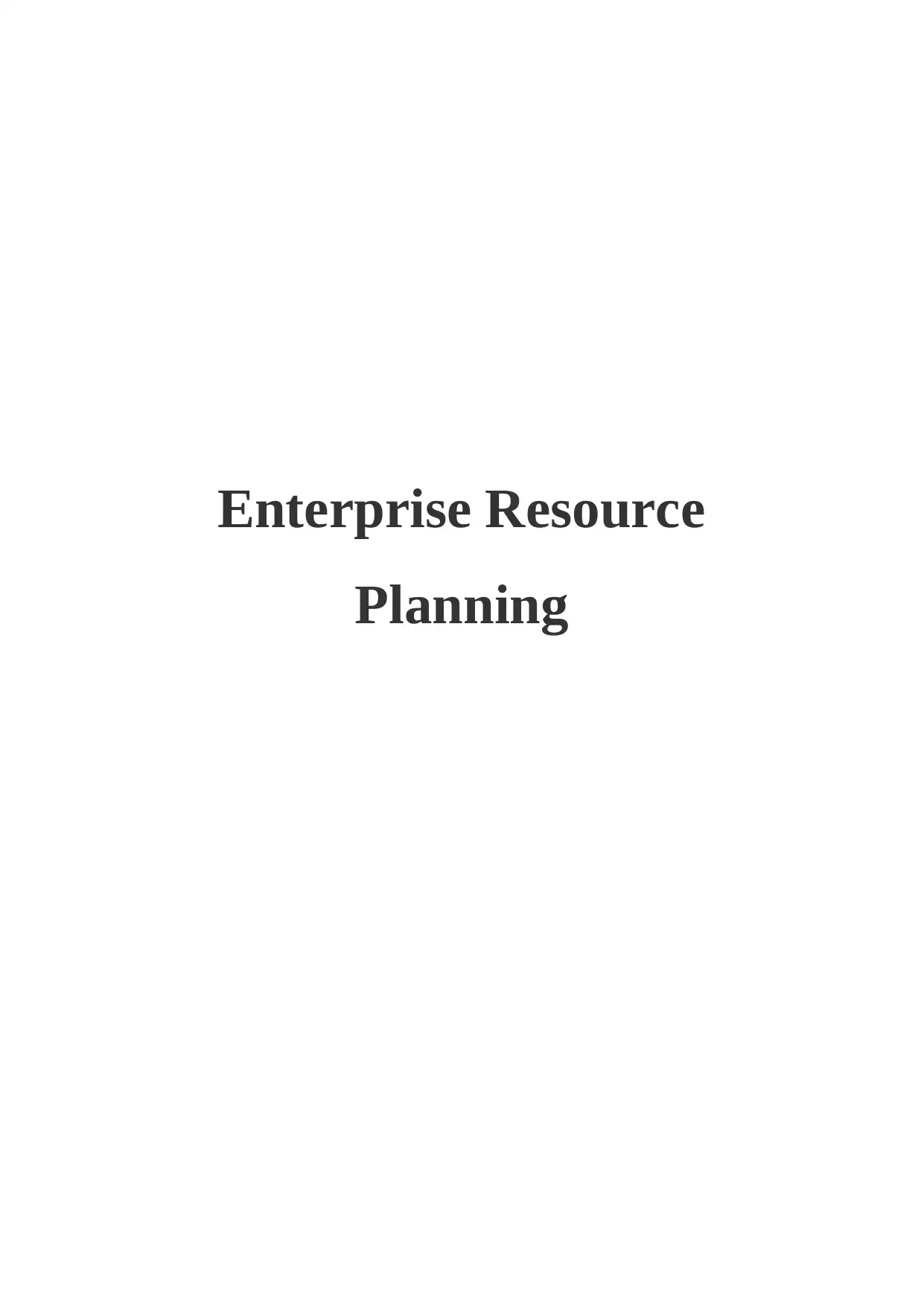
Enterprise Resource
Planning
Planning
Paraphrase This Document
Need a fresh take? Get an instant paraphrase of this document with our AI Paraphraser
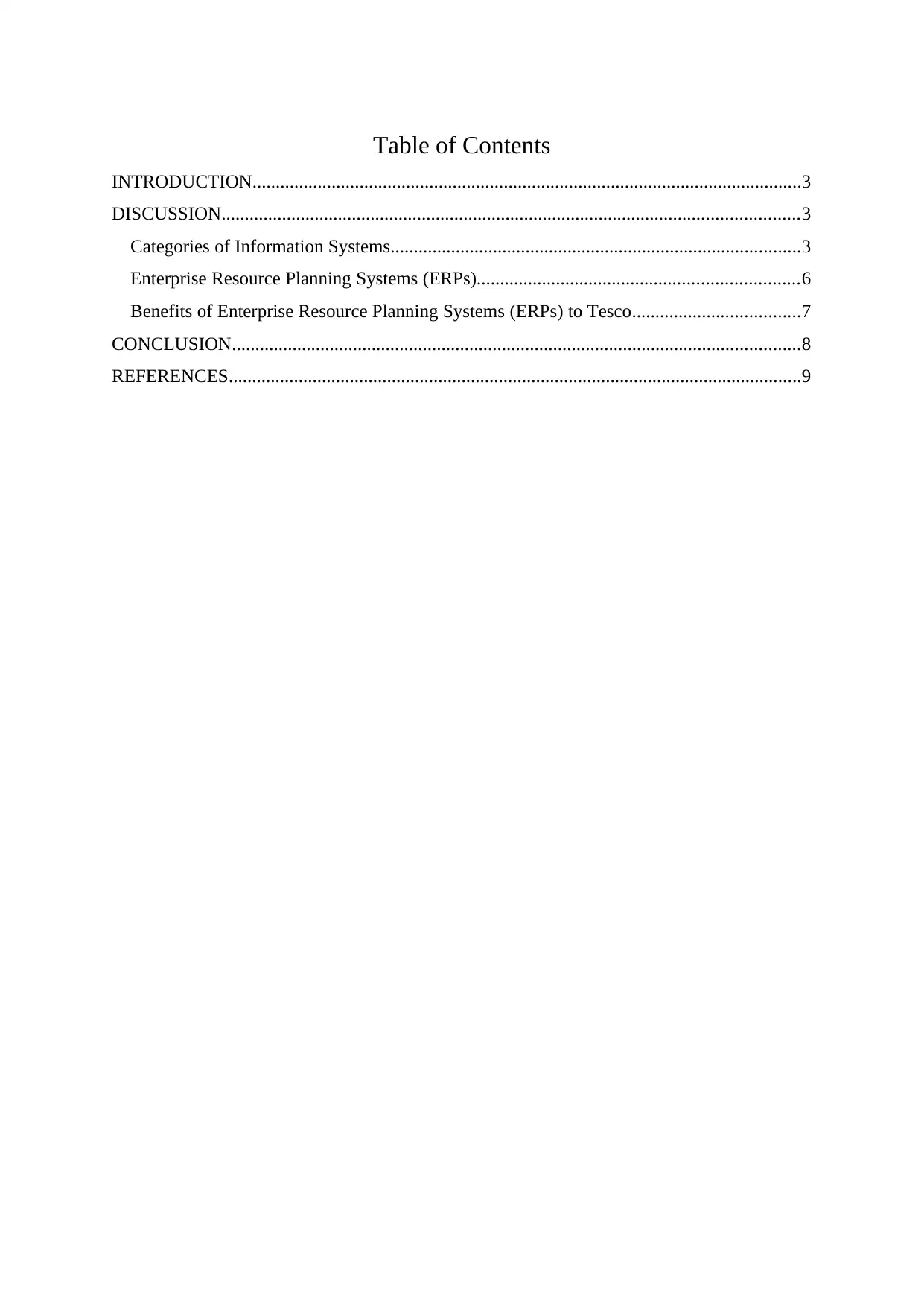
Table of Contents
INTRODUCTION......................................................................................................................3
DISCUSSION............................................................................................................................3
Categories of Information Systems........................................................................................3
Enterprise Resource Planning Systems (ERPs).....................................................................6
Benefits of Enterprise Resource Planning Systems (ERPs) to Tesco....................................7
CONCLUSION..........................................................................................................................8
REFERENCES...........................................................................................................................9
INTRODUCTION......................................................................................................................3
DISCUSSION............................................................................................................................3
Categories of Information Systems........................................................................................3
Enterprise Resource Planning Systems (ERPs).....................................................................6
Benefits of Enterprise Resource Planning Systems (ERPs) to Tesco....................................7
CONCLUSION..........................................................................................................................8
REFERENCES...........................................................................................................................9

INTRODUCTION
Information Systems comprise of all integrated components that are used at a business
organisation to record, store and analyse user data. These digital systems aid business
organisations in interacting with their suppliers and consumers, manage their operations
dynamically and granting them a competitive advantage amongst their competitors in the
market. Information systems also enhance the interorganisational operations of supply chains
and digital markets (Laurini, 2018). Information systems are also used by business
organisations in order to process their operational financial accounts, effectively mass market
to a wide section of potential customers and to manage their human resource functions. Due
to their wide ranging applications which effectively provide greater control to business
organisations and allow them to record, store and analyse the progress of their operations
dynamically through digital means, use of information systems at business organisations
provides them with immense benefits that allows them to increase their productivity and
efficiency in the markets while granting them a competitive advantage against their
competitors.
The primary objective of this essay is to assess the different types of information
systems used in various business organisations, their operations and advantages provided and
to evaluate how Enterprise Resource Planning systems (ERPs) improve a business
organisation’s data collection and have grown to become a key influencer in controlling and
managing a business’s total information streams. This report studies the various types of
information systems that are implemented in organisations today. It also evaluates the
concept of Enterprise Resource Planning systems and how it aids the operation and
performance of a business organisation. The report also analyses the multiple advantages
these ERP systems provides to real life business organisations and recommends ways which
business organisations can use in order to further improve their Enterprise Resource Planning
system’s operations in order to further increase their operational productivity, efficiency and
profitability.
Information Systems comprise of all integrated components that are used at a business
organisation to record, store and analyse user data. These digital systems aid business
organisations in interacting with their suppliers and consumers, manage their operations
dynamically and granting them a competitive advantage amongst their competitors in the
market. Information systems also enhance the interorganisational operations of supply chains
and digital markets (Laurini, 2018). Information systems are also used by business
organisations in order to process their operational financial accounts, effectively mass market
to a wide section of potential customers and to manage their human resource functions. Due
to their wide ranging applications which effectively provide greater control to business
organisations and allow them to record, store and analyse the progress of their operations
dynamically through digital means, use of information systems at business organisations
provides them with immense benefits that allows them to increase their productivity and
efficiency in the markets while granting them a competitive advantage against their
competitors.
The primary objective of this essay is to assess the different types of information
systems used in various business organisations, their operations and advantages provided and
to evaluate how Enterprise Resource Planning systems (ERPs) improve a business
organisation’s data collection and have grown to become a key influencer in controlling and
managing a business’s total information streams. This report studies the various types of
information systems that are implemented in organisations today. It also evaluates the
concept of Enterprise Resource Planning systems and how it aids the operation and
performance of a business organisation. The report also analyses the multiple advantages
these ERP systems provides to real life business organisations and recommends ways which
business organisations can use in order to further improve their Enterprise Resource Planning
system’s operations in order to further increase their operational productivity, efficiency and
profitability.
⊘ This is a preview!⊘
Do you want full access?
Subscribe today to unlock all pages.

Trusted by 1+ million students worldwide
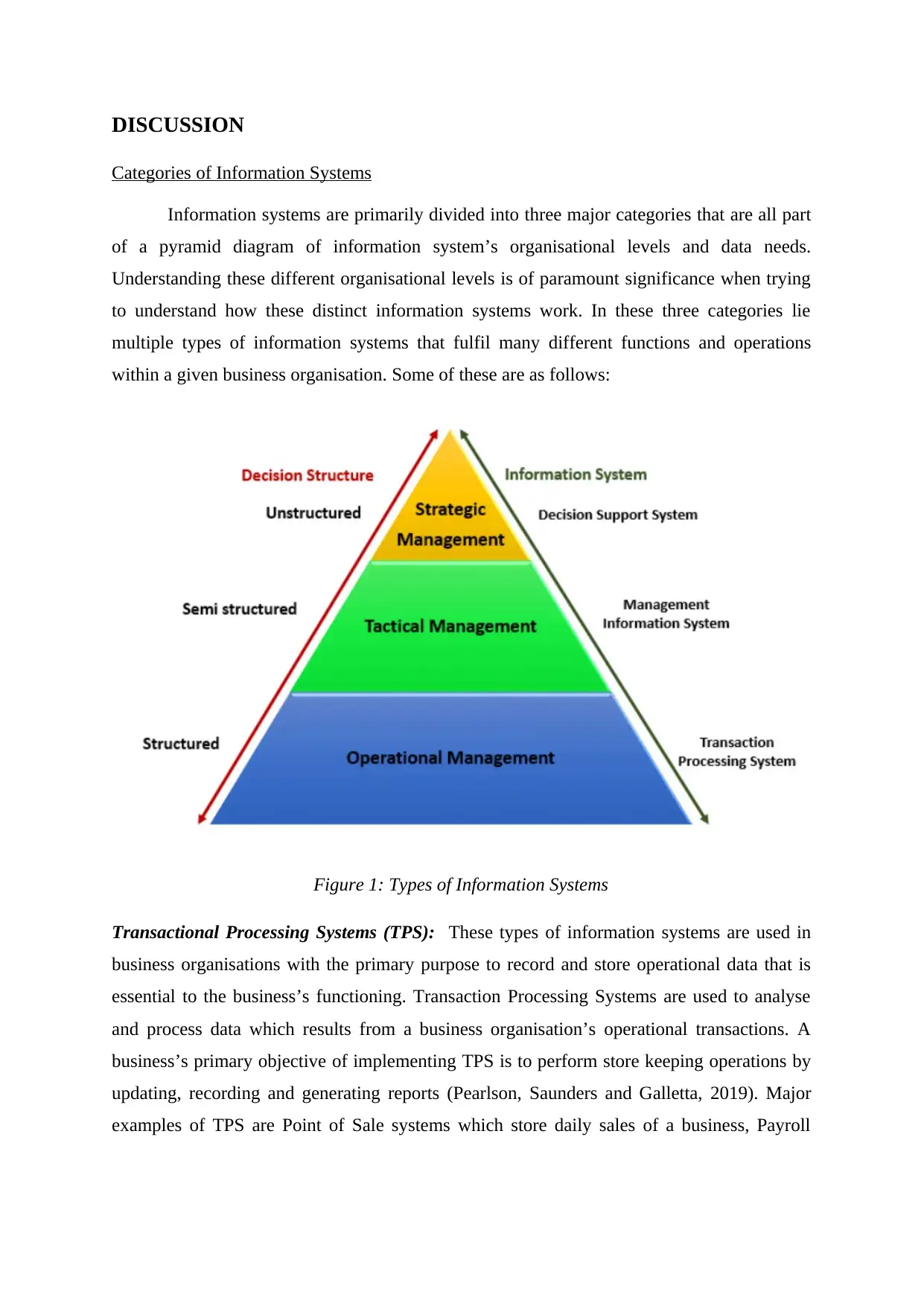
DISCUSSION
Categories of Information Systems
Information systems are primarily divided into three major categories that are all part
of a pyramid diagram of information system’s organisational levels and data needs.
Understanding these different organisational levels is of paramount significance when trying
to understand how these distinct information systems work. In these three categories lie
multiple types of information systems that fulfil many different functions and operations
within a given business organisation. Some of these are as follows:
Figure 1: Types of Information Systems
Transactional Processing Systems (TPS): These types of information systems are used in
business organisations with the primary purpose to record and store operational data that is
essential to the business’s functioning. Transaction Processing Systems are used to analyse
and process data which results from a business organisation’s operational transactions. A
business’s primary objective of implementing TPS is to perform store keeping operations by
updating, recording and generating reports (Pearlson, Saunders and Galletta, 2019). Major
examples of TPS are Point of Sale systems which store daily sales of a business, Payroll
Categories of Information Systems
Information systems are primarily divided into three major categories that are all part
of a pyramid diagram of information system’s organisational levels and data needs.
Understanding these different organisational levels is of paramount significance when trying
to understand how these distinct information systems work. In these three categories lie
multiple types of information systems that fulfil many different functions and operations
within a given business organisation. Some of these are as follows:
Figure 1: Types of Information Systems
Transactional Processing Systems (TPS): These types of information systems are used in
business organisations with the primary purpose to record and store operational data that is
essential to the business’s functioning. Transaction Processing Systems are used to analyse
and process data which results from a business organisation’s operational transactions. A
business’s primary objective of implementing TPS is to perform store keeping operations by
updating, recording and generating reports (Pearlson, Saunders and Galletta, 2019). Major
examples of TPS are Point of Sale systems which store daily sales of a business, Payroll
Paraphrase This Document
Need a fresh take? Get an instant paraphrase of this document with our AI Paraphraser
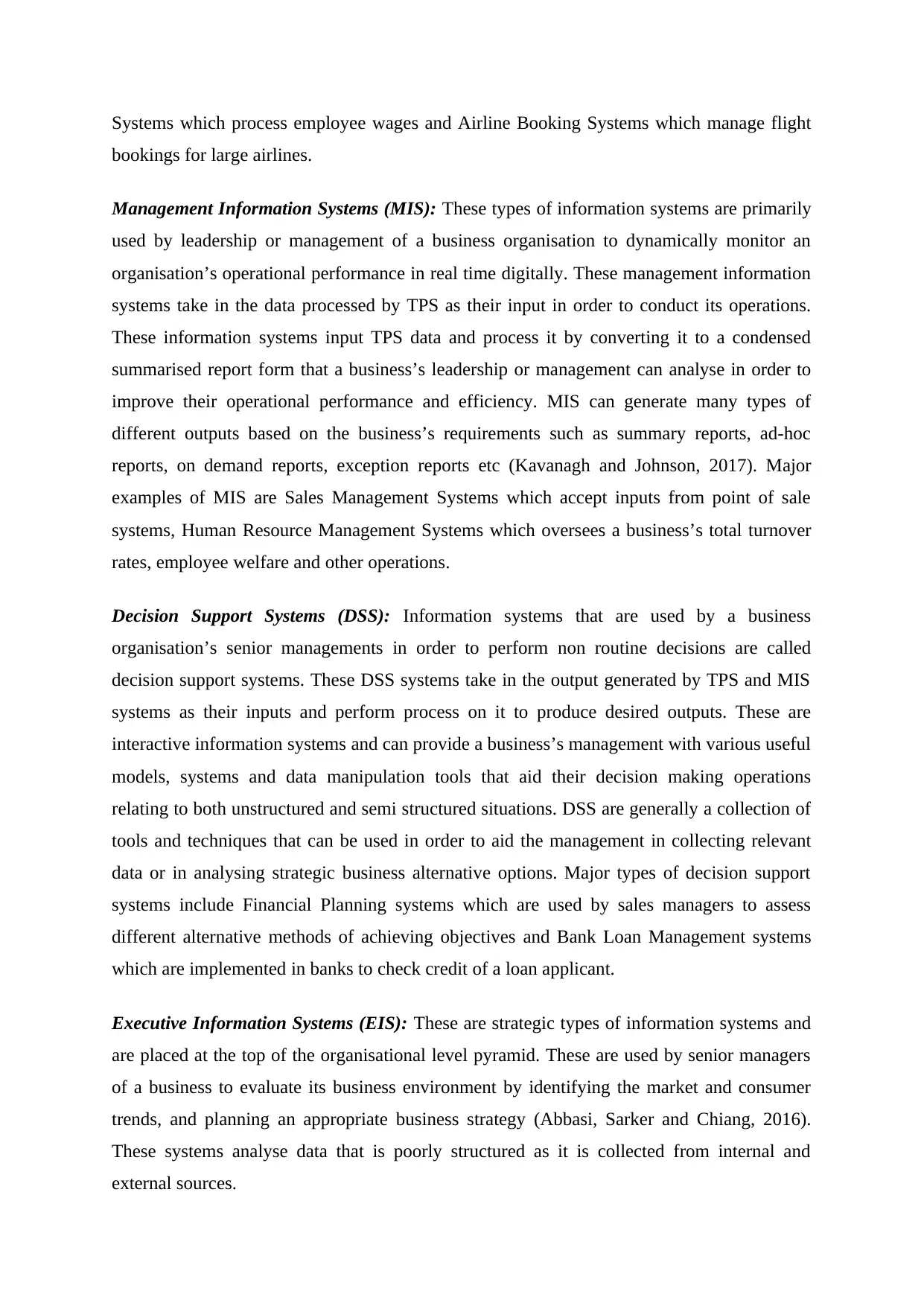
Systems which process employee wages and Airline Booking Systems which manage flight
bookings for large airlines.
Management Information Systems (MIS): These types of information systems are primarily
used by leadership or management of a business organisation to dynamically monitor an
organisation’s operational performance in real time digitally. These management information
systems take in the data processed by TPS as their input in order to conduct its operations.
These information systems input TPS data and process it by converting it to a condensed
summarised report form that a business’s leadership or management can analyse in order to
improve their operational performance and efficiency. MIS can generate many types of
different outputs based on the business’s requirements such as summary reports, ad-hoc
reports, on demand reports, exception reports etc (Kavanagh and Johnson, 2017). Major
examples of MIS are Sales Management Systems which accept inputs from point of sale
systems, Human Resource Management Systems which oversees a business’s total turnover
rates, employee welfare and other operations.
Decision Support Systems (DSS): Information systems that are used by a business
organisation’s senior managements in order to perform non routine decisions are called
decision support systems. These DSS systems take in the output generated by TPS and MIS
systems as their inputs and perform process on it to produce desired outputs. These are
interactive information systems and can provide a business’s management with various useful
models, systems and data manipulation tools that aid their decision making operations
relating to both unstructured and semi structured situations. DSS are generally a collection of
tools and techniques that can be used in order to aid the management in collecting relevant
data or in analysing strategic business alternative options. Major types of decision support
systems include Financial Planning systems which are used by sales managers to assess
different alternative methods of achieving objectives and Bank Loan Management systems
which are implemented in banks to check credit of a loan applicant.
Executive Information Systems (EIS): These are strategic types of information systems and
are placed at the top of the organisational level pyramid. These are used by senior managers
of a business to evaluate its business environment by identifying the market and consumer
trends, and planning an appropriate business strategy (Abbasi, Sarker and Chiang, 2016).
These systems analyse data that is poorly structured as it is collected from internal and
external sources.
bookings for large airlines.
Management Information Systems (MIS): These types of information systems are primarily
used by leadership or management of a business organisation to dynamically monitor an
organisation’s operational performance in real time digitally. These management information
systems take in the data processed by TPS as their input in order to conduct its operations.
These information systems input TPS data and process it by converting it to a condensed
summarised report form that a business’s leadership or management can analyse in order to
improve their operational performance and efficiency. MIS can generate many types of
different outputs based on the business’s requirements such as summary reports, ad-hoc
reports, on demand reports, exception reports etc (Kavanagh and Johnson, 2017). Major
examples of MIS are Sales Management Systems which accept inputs from point of sale
systems, Human Resource Management Systems which oversees a business’s total turnover
rates, employee welfare and other operations.
Decision Support Systems (DSS): Information systems that are used by a business
organisation’s senior managements in order to perform non routine decisions are called
decision support systems. These DSS systems take in the output generated by TPS and MIS
systems as their inputs and perform process on it to produce desired outputs. These are
interactive information systems and can provide a business’s management with various useful
models, systems and data manipulation tools that aid their decision making operations
relating to both unstructured and semi structured situations. DSS are generally a collection of
tools and techniques that can be used in order to aid the management in collecting relevant
data or in analysing strategic business alternative options. Major types of decision support
systems include Financial Planning systems which are used by sales managers to assess
different alternative methods of achieving objectives and Bank Loan Management systems
which are implemented in banks to check credit of a loan applicant.
Executive Information Systems (EIS): These are strategic types of information systems and
are placed at the top of the organisational level pyramid. These are used by senior managers
of a business to evaluate its business environment by identifying the market and consumer
trends, and planning an appropriate business strategy (Abbasi, Sarker and Chiang, 2016).
These systems analyse data that is poorly structured as it is collected from internal and
external sources.
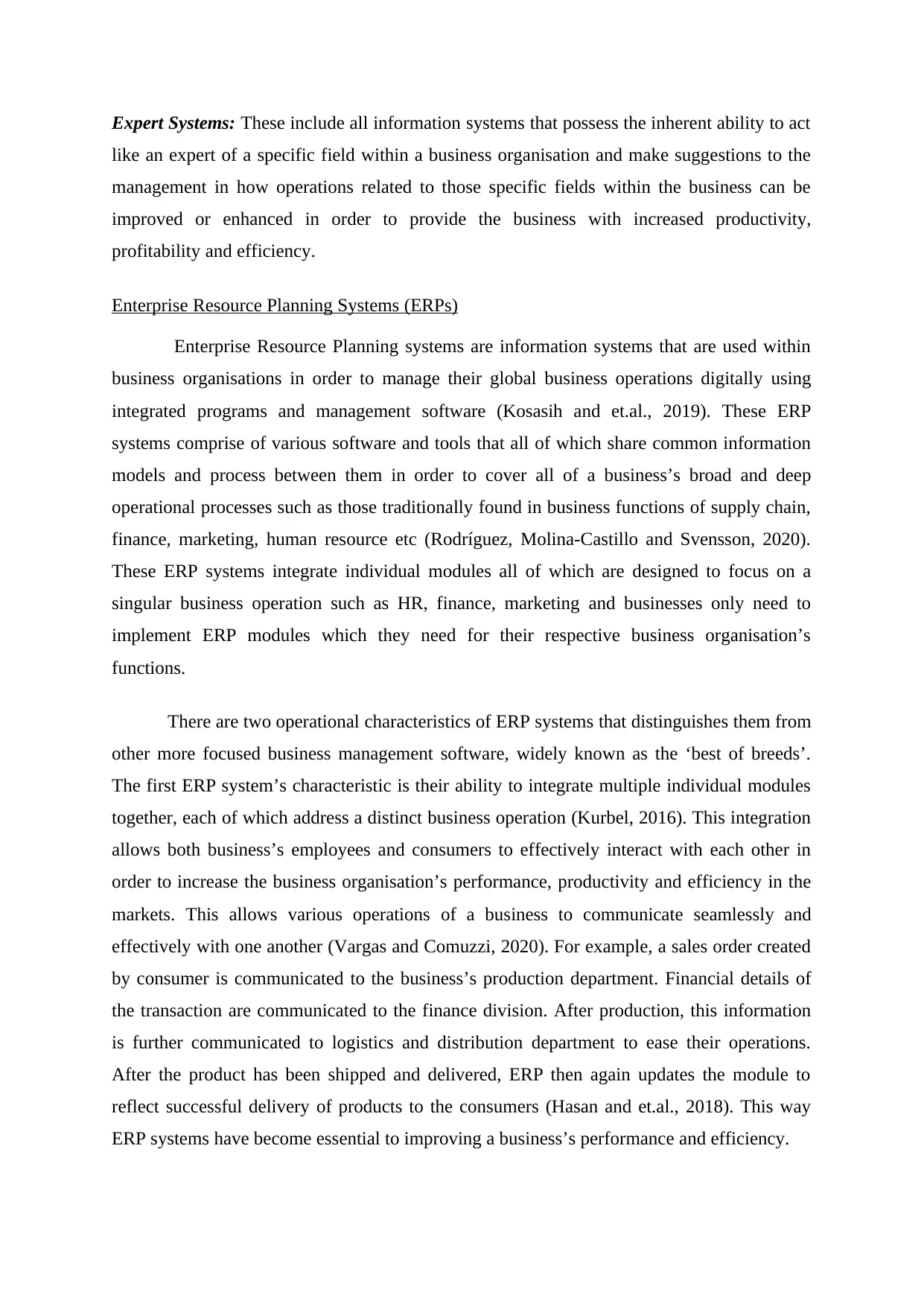
Expert Systems: These include all information systems that possess the inherent ability to act
like an expert of a specific field within a business organisation and make suggestions to the
management in how operations related to those specific fields within the business can be
improved or enhanced in order to provide the business with increased productivity,
profitability and efficiency.
Enterprise Resource Planning Systems (ERPs)
Enterprise Resource Planning systems are information systems that are used within
business organisations in order to manage their global business operations digitally using
integrated programs and management software (Kosasih and et.al., 2019). These ERP
systems comprise of various software and tools that all of which share common information
models and process between them in order to cover all of a business’s broad and deep
operational processes such as those traditionally found in business functions of supply chain,
finance, marketing, human resource etc (Rodríguez, Molina-Castillo and Svensson, 2020).
These ERP systems integrate individual modules all of which are designed to focus on a
singular business operation such as HR, finance, marketing and businesses only need to
implement ERP modules which they need for their respective business organisation’s
functions.
There are two operational characteristics of ERP systems that distinguishes them from
other more focused business management software, widely known as the ‘best of breeds’.
The first ERP system’s characteristic is their ability to integrate multiple individual modules
together, each of which address a distinct business operation (Kurbel, 2016). This integration
allows both business’s employees and consumers to effectively interact with each other in
order to increase the business organisation’s performance, productivity and efficiency in the
markets. This allows various operations of a business to communicate seamlessly and
effectively with one another (Vargas and Comuzzi, 2020). For example, a sales order created
by consumer is communicated to the business’s production department. Financial details of
the transaction are communicated to the finance division. After production, this information
is further communicated to logistics and distribution department to ease their operations.
After the product has been shipped and delivered, ERP then again updates the module to
reflect successful delivery of products to the consumers (Hasan and et.al., 2018). This way
ERP systems have become essential to improving a business’s performance and efficiency.
like an expert of a specific field within a business organisation and make suggestions to the
management in how operations related to those specific fields within the business can be
improved or enhanced in order to provide the business with increased productivity,
profitability and efficiency.
Enterprise Resource Planning Systems (ERPs)
Enterprise Resource Planning systems are information systems that are used within
business organisations in order to manage their global business operations digitally using
integrated programs and management software (Kosasih and et.al., 2019). These ERP
systems comprise of various software and tools that all of which share common information
models and process between them in order to cover all of a business’s broad and deep
operational processes such as those traditionally found in business functions of supply chain,
finance, marketing, human resource etc (Rodríguez, Molina-Castillo and Svensson, 2020).
These ERP systems integrate individual modules all of which are designed to focus on a
singular business operation such as HR, finance, marketing and businesses only need to
implement ERP modules which they need for their respective business organisation’s
functions.
There are two operational characteristics of ERP systems that distinguishes them from
other more focused business management software, widely known as the ‘best of breeds’.
The first ERP system’s characteristic is their ability to integrate multiple individual modules
together, each of which address a distinct business operation (Kurbel, 2016). This integration
allows both business’s employees and consumers to effectively interact with each other in
order to increase the business organisation’s performance, productivity and efficiency in the
markets. This allows various operations of a business to communicate seamlessly and
effectively with one another (Vargas and Comuzzi, 2020). For example, a sales order created
by consumer is communicated to the business’s production department. Financial details of
the transaction are communicated to the finance division. After production, this information
is further communicated to logistics and distribution department to ease their operations.
After the product has been shipped and delivered, ERP then again updates the module to
reflect successful delivery of products to the consumers (Hasan and et.al., 2018). This way
ERP systems have become essential to improving a business’s performance and efficiency.
⊘ This is a preview!⊘
Do you want full access?
Subscribe today to unlock all pages.

Trusted by 1+ million students worldwide
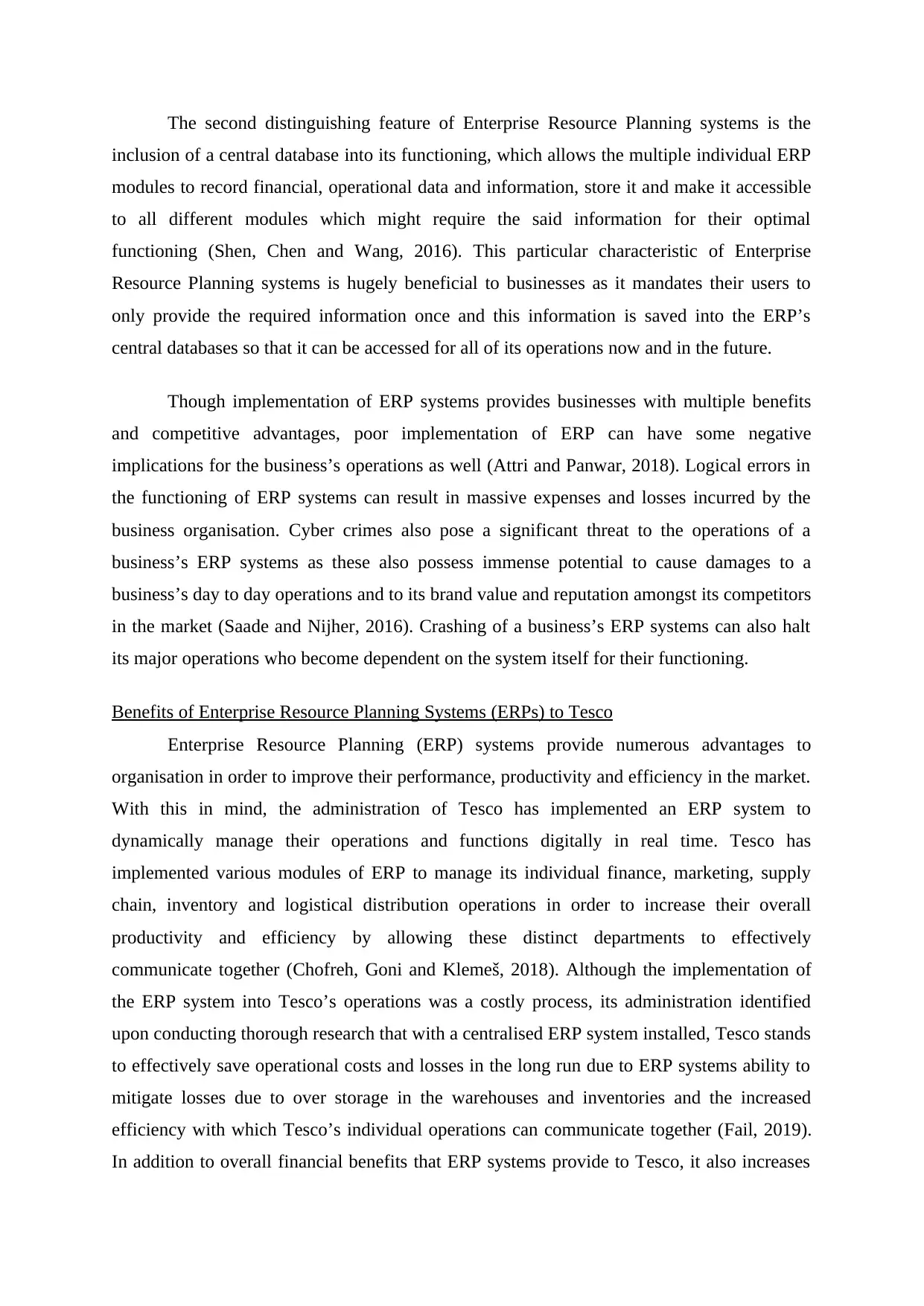
The second distinguishing feature of Enterprise Resource Planning systems is the
inclusion of a central database into its functioning, which allows the multiple individual ERP
modules to record financial, operational data and information, store it and make it accessible
to all different modules which might require the said information for their optimal
functioning (Shen, Chen and Wang, 2016). This particular characteristic of Enterprise
Resource Planning systems is hugely beneficial to businesses as it mandates their users to
only provide the required information once and this information is saved into the ERP’s
central databases so that it can be accessed for all of its operations now and in the future.
Though implementation of ERP systems provides businesses with multiple benefits
and competitive advantages, poor implementation of ERP can have some negative
implications for the business’s operations as well (Attri and Panwar, 2018). Logical errors in
the functioning of ERP systems can result in massive expenses and losses incurred by the
business organisation. Cyber crimes also pose a significant threat to the operations of a
business’s ERP systems as these also possess immense potential to cause damages to a
business’s day to day operations and to its brand value and reputation amongst its competitors
in the market (Saade and Nijher, 2016). Crashing of a business’s ERP systems can also halt
its major operations who become dependent on the system itself for their functioning.
Benefits of Enterprise Resource Planning Systems (ERPs) to Tesco
Enterprise Resource Planning (ERP) systems provide numerous advantages to
organisation in order to improve their performance, productivity and efficiency in the market.
With this in mind, the administration of Tesco has implemented an ERP system to
dynamically manage their operations and functions digitally in real time. Tesco has
implemented various modules of ERP to manage its individual finance, marketing, supply
chain, inventory and logistical distribution operations in order to increase their overall
productivity and efficiency by allowing these distinct departments to effectively
communicate together (Chofreh, Goni and Klemeš, 2018). Although the implementation of
the ERP system into Tesco’s operations was a costly process, its administration identified
upon conducting thorough research that with a centralised ERP system installed, Tesco stands
to effectively save operational costs and losses in the long run due to ERP systems ability to
mitigate losses due to over storage in the warehouses and inventories and the increased
efficiency with which Tesco’s individual operations can communicate together (Fail, 2019).
In addition to overall financial benefits that ERP systems provide to Tesco, it also increases
inclusion of a central database into its functioning, which allows the multiple individual ERP
modules to record financial, operational data and information, store it and make it accessible
to all different modules which might require the said information for their optimal
functioning (Shen, Chen and Wang, 2016). This particular characteristic of Enterprise
Resource Planning systems is hugely beneficial to businesses as it mandates their users to
only provide the required information once and this information is saved into the ERP’s
central databases so that it can be accessed for all of its operations now and in the future.
Though implementation of ERP systems provides businesses with multiple benefits
and competitive advantages, poor implementation of ERP can have some negative
implications for the business’s operations as well (Attri and Panwar, 2018). Logical errors in
the functioning of ERP systems can result in massive expenses and losses incurred by the
business organisation. Cyber crimes also pose a significant threat to the operations of a
business’s ERP systems as these also possess immense potential to cause damages to a
business’s day to day operations and to its brand value and reputation amongst its competitors
in the market (Saade and Nijher, 2016). Crashing of a business’s ERP systems can also halt
its major operations who become dependent on the system itself for their functioning.
Benefits of Enterprise Resource Planning Systems (ERPs) to Tesco
Enterprise Resource Planning (ERP) systems provide numerous advantages to
organisation in order to improve their performance, productivity and efficiency in the market.
With this in mind, the administration of Tesco has implemented an ERP system to
dynamically manage their operations and functions digitally in real time. Tesco has
implemented various modules of ERP to manage its individual finance, marketing, supply
chain, inventory and logistical distribution operations in order to increase their overall
productivity and efficiency by allowing these distinct departments to effectively
communicate together (Chofreh, Goni and Klemeš, 2018). Although the implementation of
the ERP system into Tesco’s operations was a costly process, its administration identified
upon conducting thorough research that with a centralised ERP system installed, Tesco stands
to effectively save operational costs and losses in the long run due to ERP systems ability to
mitigate losses due to over storage in the warehouses and inventories and the increased
efficiency with which Tesco’s individual operations can communicate together (Fail, 2019).
In addition to overall financial benefits that ERP systems provide to Tesco, it also increases
Paraphrase This Document
Need a fresh take? Get an instant paraphrase of this document with our AI Paraphraser
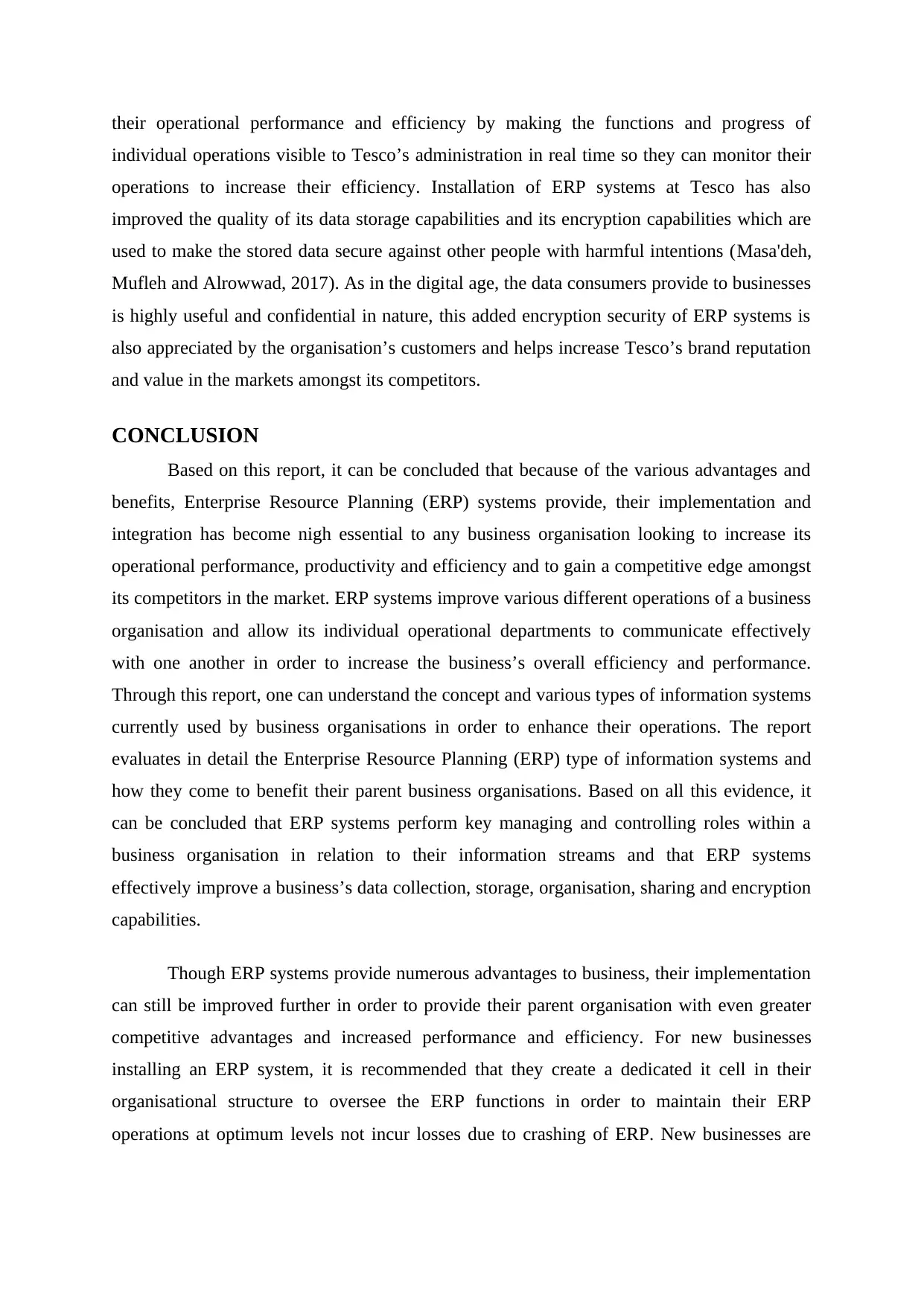
their operational performance and efficiency by making the functions and progress of
individual operations visible to Tesco’s administration in real time so they can monitor their
operations to increase their efficiency. Installation of ERP systems at Tesco has also
improved the quality of its data storage capabilities and its encryption capabilities which are
used to make the stored data secure against other people with harmful intentions (Masa'deh,
Mufleh and Alrowwad, 2017). As in the digital age, the data consumers provide to businesses
is highly useful and confidential in nature, this added encryption security of ERP systems is
also appreciated by the organisation’s customers and helps increase Tesco’s brand reputation
and value in the markets amongst its competitors.
CONCLUSION
Based on this report, it can be concluded that because of the various advantages and
benefits, Enterprise Resource Planning (ERP) systems provide, their implementation and
integration has become nigh essential to any business organisation looking to increase its
operational performance, productivity and efficiency and to gain a competitive edge amongst
its competitors in the market. ERP systems improve various different operations of a business
organisation and allow its individual operational departments to communicate effectively
with one another in order to increase the business’s overall efficiency and performance.
Through this report, one can understand the concept and various types of information systems
currently used by business organisations in order to enhance their operations. The report
evaluates in detail the Enterprise Resource Planning (ERP) type of information systems and
how they come to benefit their parent business organisations. Based on all this evidence, it
can be concluded that ERP systems perform key managing and controlling roles within a
business organisation in relation to their information streams and that ERP systems
effectively improve a business’s data collection, storage, organisation, sharing and encryption
capabilities.
Though ERP systems provide numerous advantages to business, their implementation
can still be improved further in order to provide their parent organisation with even greater
competitive advantages and increased performance and efficiency. For new businesses
installing an ERP system, it is recommended that they create a dedicated it cell in their
organisational structure to oversee the ERP functions in order to maintain their ERP
operations at optimum levels not incur losses due to crashing of ERP. New businesses are
individual operations visible to Tesco’s administration in real time so they can monitor their
operations to increase their efficiency. Installation of ERP systems at Tesco has also
improved the quality of its data storage capabilities and its encryption capabilities which are
used to make the stored data secure against other people with harmful intentions (Masa'deh,
Mufleh and Alrowwad, 2017). As in the digital age, the data consumers provide to businesses
is highly useful and confidential in nature, this added encryption security of ERP systems is
also appreciated by the organisation’s customers and helps increase Tesco’s brand reputation
and value in the markets amongst its competitors.
CONCLUSION
Based on this report, it can be concluded that because of the various advantages and
benefits, Enterprise Resource Planning (ERP) systems provide, their implementation and
integration has become nigh essential to any business organisation looking to increase its
operational performance, productivity and efficiency and to gain a competitive edge amongst
its competitors in the market. ERP systems improve various different operations of a business
organisation and allow its individual operational departments to communicate effectively
with one another in order to increase the business’s overall efficiency and performance.
Through this report, one can understand the concept and various types of information systems
currently used by business organisations in order to enhance their operations. The report
evaluates in detail the Enterprise Resource Planning (ERP) type of information systems and
how they come to benefit their parent business organisations. Based on all this evidence, it
can be concluded that ERP systems perform key managing and controlling roles within a
business organisation in relation to their information streams and that ERP systems
effectively improve a business’s data collection, storage, organisation, sharing and encryption
capabilities.
Though ERP systems provide numerous advantages to business, their implementation
can still be improved further in order to provide their parent organisation with even greater
competitive advantages and increased performance and efficiency. For new businesses
installing an ERP system, it is recommended that they create a dedicated it cell in their
organisational structure to oversee the ERP functions in order to maintain their ERP
operations at optimum levels not incur losses due to crashing of ERP. New businesses are

also required to impart all necessary training to these employees in their task to maintain the
business’s ERP system for overall increased operational performance and efficiency.
business’s ERP system for overall increased operational performance and efficiency.
⊘ This is a preview!⊘
Do you want full access?
Subscribe today to unlock all pages.

Trusted by 1+ million students worldwide
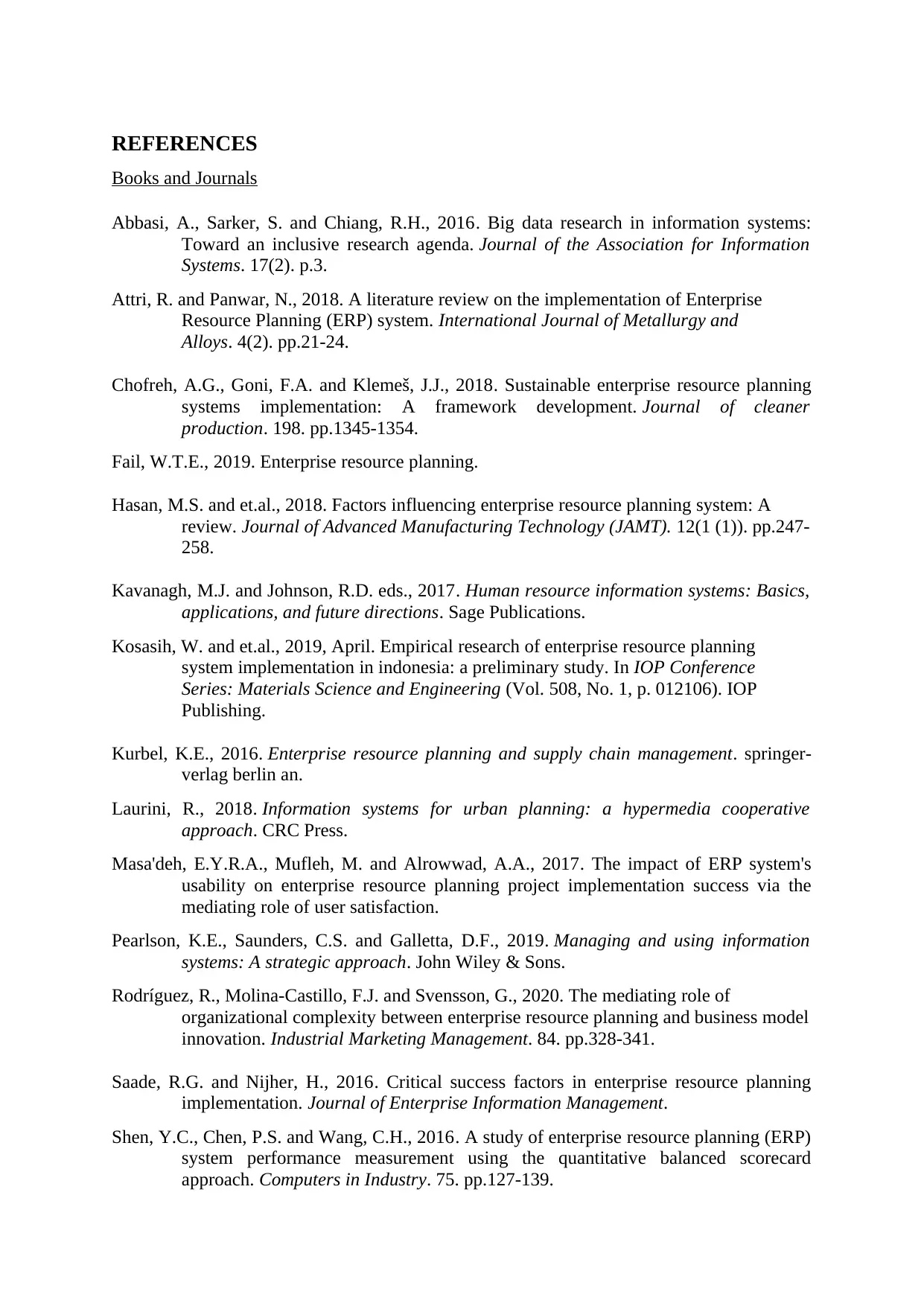
REFERENCES
Books and Journals
Abbasi, A., Sarker, S. and Chiang, R.H., 2016. Big data research in information systems:
Toward an inclusive research agenda. Journal of the Association for Information
Systems. 17(2). p.3.
Attri, R. and Panwar, N., 2018. A literature review on the implementation of Enterprise
Resource Planning (ERP) system. International Journal of Metallurgy and
Alloys. 4(2). pp.21-24.
Chofreh, A.G., Goni, F.A. and Klemeš, J.J., 2018. Sustainable enterprise resource planning
systems implementation: A framework development. Journal of cleaner
production. 198. pp.1345-1354.
Fail, W.T.E., 2019. Enterprise resource planning.
Hasan, M.S. and et.al., 2018. Factors influencing enterprise resource planning system: A
review. Journal of Advanced Manufacturing Technology (JAMT). 12(1 (1)). pp.247-
258.
Kavanagh, M.J. and Johnson, R.D. eds., 2017. Human resource information systems: Basics,
applications, and future directions. Sage Publications.
Kosasih, W. and et.al., 2019, April. Empirical research of enterprise resource planning
system implementation in indonesia: a preliminary study. In IOP Conference
Series: Materials Science and Engineering (Vol. 508, No. 1, p. 012106). IOP
Publishing.
Kurbel, K.E., 2016. Enterprise resource planning and supply chain management. springer-
verlag berlin an.
Laurini, R., 2018. Information systems for urban planning: a hypermedia cooperative
approach. CRC Press.
Masa'deh, E.Y.R.A., Mufleh, M. and Alrowwad, A.A., 2017. The impact of ERP system's
usability on enterprise resource planning project implementation success via the
mediating role of user satisfaction.
Pearlson, K.E., Saunders, C.S. and Galletta, D.F., 2019. Managing and using information
systems: A strategic approach. John Wiley & Sons.
Rodríguez, R., Molina-Castillo, F.J. and Svensson, G., 2020. The mediating role of
organizational complexity between enterprise resource planning and business model
innovation. Industrial Marketing Management. 84. pp.328-341.
Saade, R.G. and Nijher, H., 2016. Critical success factors in enterprise resource planning
implementation. Journal of Enterprise Information Management.
Shen, Y.C., Chen, P.S. and Wang, C.H., 2016. A study of enterprise resource planning (ERP)
system performance measurement using the quantitative balanced scorecard
approach. Computers in Industry. 75. pp.127-139.
Books and Journals
Abbasi, A., Sarker, S. and Chiang, R.H., 2016. Big data research in information systems:
Toward an inclusive research agenda. Journal of the Association for Information
Systems. 17(2). p.3.
Attri, R. and Panwar, N., 2018. A literature review on the implementation of Enterprise
Resource Planning (ERP) system. International Journal of Metallurgy and
Alloys. 4(2). pp.21-24.
Chofreh, A.G., Goni, F.A. and Klemeš, J.J., 2018. Sustainable enterprise resource planning
systems implementation: A framework development. Journal of cleaner
production. 198. pp.1345-1354.
Fail, W.T.E., 2019. Enterprise resource planning.
Hasan, M.S. and et.al., 2018. Factors influencing enterprise resource planning system: A
review. Journal of Advanced Manufacturing Technology (JAMT). 12(1 (1)). pp.247-
258.
Kavanagh, M.J. and Johnson, R.D. eds., 2017. Human resource information systems: Basics,
applications, and future directions. Sage Publications.
Kosasih, W. and et.al., 2019, April. Empirical research of enterprise resource planning
system implementation in indonesia: a preliminary study. In IOP Conference
Series: Materials Science and Engineering (Vol. 508, No. 1, p. 012106). IOP
Publishing.
Kurbel, K.E., 2016. Enterprise resource planning and supply chain management. springer-
verlag berlin an.
Laurini, R., 2018. Information systems for urban planning: a hypermedia cooperative
approach. CRC Press.
Masa'deh, E.Y.R.A., Mufleh, M. and Alrowwad, A.A., 2017. The impact of ERP system's
usability on enterprise resource planning project implementation success via the
mediating role of user satisfaction.
Pearlson, K.E., Saunders, C.S. and Galletta, D.F., 2019. Managing and using information
systems: A strategic approach. John Wiley & Sons.
Rodríguez, R., Molina-Castillo, F.J. and Svensson, G., 2020. The mediating role of
organizational complexity between enterprise resource planning and business model
innovation. Industrial Marketing Management. 84. pp.328-341.
Saade, R.G. and Nijher, H., 2016. Critical success factors in enterprise resource planning
implementation. Journal of Enterprise Information Management.
Shen, Y.C., Chen, P.S. and Wang, C.H., 2016. A study of enterprise resource planning (ERP)
system performance measurement using the quantitative balanced scorecard
approach. Computers in Industry. 75. pp.127-139.
Paraphrase This Document
Need a fresh take? Get an instant paraphrase of this document with our AI Paraphraser

Vargas, M.A. and Comuzzi, M., 2020. A multi-dimensional model of Enterprise Resource
Planning critical success factors. Enterprise Information Systems. 14(1). pp.38-57.
Planning critical success factors. Enterprise Information Systems. 14(1). pp.38-57.
1 out of 11
Related Documents
Your All-in-One AI-Powered Toolkit for Academic Success.
+13062052269
info@desklib.com
Available 24*7 on WhatsApp / Email
![[object Object]](/_next/static/media/star-bottom.7253800d.svg)
Unlock your academic potential
Copyright © 2020–2025 A2Z Services. All Rights Reserved. Developed and managed by ZUCOL.





